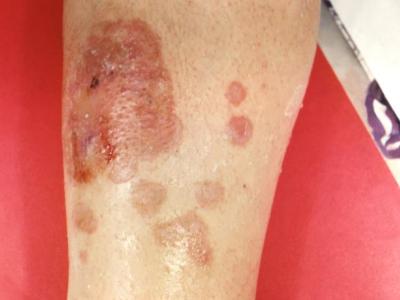Cases at 2nd New Jersey peds facility caused by different adenovirus strain
The New Jersey Department of Health (NJ Health) said preliminary tests on four adenovirus cases among pediatric patients at Voorhees Pediatric Facility in Voorhees, N.J., ruled out type 7, the strain of adenovirus responsible for 10 deaths and 27 illnesses at the Wanaque Center for Nursing and Rehabilitation in Haskell, N.J., according to an NJ Health news release
Patients at Voorhees reported symptom onset from Oct 20 to 27. The hospital has closed its doors to new admissions while it waits on more test results from the US Centers for Disease Control and Prevention.
"The pediatric patients in Voorhees do not have the severity of illnesses we're seeing among residents at the Wanaque Center for Nursing and Rehabilitation," said New Jersey Health Commissioner Shereef Elnahal, MD in a press release. "While we cannot release private medical information, these patients in Voorhees are not in critical condition."
On Oct 9, New Jersey was notified of a fatal adenovirus outbreak in Wanaque Center for Nursing and Rehabilitation, mostly among children. Typically, adenovirus causes mild respiratory illness, but the virus can be more serious in sick and immunocompromised people.
In an unrelated outbreak, ProMed Mail, the reporting system of the International Society for Infectious Diseases, said New Jersey officials are also investigating four Acinetobacter baumannii cases identified at Newark's University Hospital since Oct 1. The infections caused the death of a premature baby.
Oct 31 NJ Health press release on Vorhees testing
Oct 31 NJ Health press release on 10th Wanaque death
Oct 29 ProMed Mail post
Study finds wide regional variation in antibiotic prescribing in Ontario
A study yesterday by Public Health Ontario found significant variability by region in outpatient antibiotic prescribing rates in the Canadian province. The findings were published in CMAJ Open, the open-access journal of the Canadian Medical Association.
The cross-sectional study looked at antibiotics dispensed from outpatient retail pharmacies in Ontario from March 2016 through February 2017, with a specific focus on comparing variability across the province's 14 health regions. Outpatient antibiotic use was presented by the number of prescriptions dispensed per 1,000 population.
A total of 8,352,578 prescriptions were dispensed during the 12-month period, or 621 per 1,000 population. Narrow-spectrum penicillins, macrolides, first-generation cephalosporins, and second-generation fluoroquinolones were the most frequently prescribed antibiotic classes. The analysis revealed that while overall variability between the regions was not statistically significant, there was a wide variation between the highest and lowest prescribing regions: from 534 to 778 antibiotics dispensed per 1,000 population. There was minimal change when the rates were adjusted for physician and population characteristics.
The analysis also found significant variability by patient age and sex, with women over 65 receiving 985 antibiotics per 1,000 population and men aged 18 to 64 receiving 441 antibiotics per 1,000 population.
"The research team suspected there was some variability in how often antibiotics were prescribed outside of hospitals and other healthcare institutions, but the level of prescribing was surprising given how much we know about appropriate prescribing, antibiotic resistance and the long-term dangers of excess prescribing," lead author Kevin Schwartz, MD, an infectious disease physician with Public Health Ontario, said in an agency press release.
Schwartz and his co-authors say the data provide an important benchmark for expansion of a provincial outpatient antimicrobial stewardship program.
Oct 31 CMAJ Open study
Oct 31 Public Health Ontario press release
China reports fatal H5N6 avian flu case; study notes cat infection
China has reported another human H5N6 avian influenza flu, this time involving a 44-year-old man from Guangxi province who died from his illness, Hong Kong's Centre for Health Protection (CHP) said yesterday in a press release.
The man is from the city of Hechi, and his symptoms began on Oct 18. He was hospitalized on Oct 21 and died on Oct 27. He denied contact with live poultry during the period before he got sick.
The highly pathogenic H5N6 strain detected in poultry outbreaks in a handful of Asian countries can infect humans in rare instances. However, China is the only country to report human cases. Since 2014 it has reported 22 human cases, which have often been fatal.
China reported its last human case in late September, a man from Guangdong province who had contact with live poultry before he became ill. The country continues to report sporadic outbreaks in poultry.
Oct 31 CHP press release
In other H5N6 developments, researchers from South Korea detailed their investigation into fatal H5N6 infections in cats that lived near poultry outbreak areas in a recent study in Emerging Infectious Diseases.
The cat deaths—one in a domestic animal and two others in outdoor cats—were first reported in the media in January 2017. The cats had sudden onset of clinical symptoms such as salivation, lethargy, convulsion, and bleeding around the mouth before they died about 4 days after illness onset. Necropsy found widespread systemic lesions, and the investigators said neurotropism of the H5N6 virus was probably a key contributor to their sudden deaths.
Genetic analysis revealed that the H5N6 virus in the cats was similar to those in poultry and had markers suggesting the virus had an increased ability to bind to respiratory tract cells and enhanced virulence in mammals. According to the report, H5N6 in cats has also been reported in China.
Oct 30 Emerg Infect Dis report
Study finds food safety gaps among farmer's market vendors
Vendors at farmer's markets aren't taking adequate steps to prevent the spread of foodborne illness and could benefit from training on ways to improve food safety, according to a 5-year study by a team from Pennsylvania State University who reported their findings today in Food Protection Trends.
The researchers directly observed Pennsylvania vendors, included observations from state sanitarians, and surveyed vendors about their practices, according to a Penn State press release.
Cathy Cutter, PhD, professor of food science at Penn State, said direct field observations and inspector findings were similar, yet different from vendors' self-reported behaviors. "The vendors think they are doing a good job, when in reality they are not. We are not sure why there were such discrepancies. Nevertheless, they need to do better," she said.
Safety gaps centered around hand washing, personal hygiene, and cross-contamination. The team found low use of disposable gloves, even among those who sell unpackaged, ready-to-eat foods. Field observation found that less than 24% had disposable gloves, though most sold raw or temperature-control-for-safety foods such as meat and seafood, plus ready-to-eat foods at the same stand. And among glove-using vendors, slightly less than half used them properly.
The researchers also tested select samples of leafy greens and meat for hygiene markers such as coliforms, fecal coliforms, Listeria, and Escherichia coli, with E coli found in 40% of beef samples, 18% of pork samples, 28% of kale samples, 29% of lettuce, and 17% of spinach samples. They detected Listeria at much lower levels in beef, kale, lettuce, and spinach.
As part of their efforts, the researchers developed a curriculum to train farmer's market vendors on food safety, which is available online through the Penn State Extension website.
Nov 1 Penn State press release
Farmer's Market Food Safety course
Measles outbreak total grows to 40 in New York's Rockland County
The number of people infected in a measles outbreak in New York's Rockland County has grown to 40 cases, up from 11 illnesses reported earlier this month.
Rockland County health officials yesterday announced more measles, mumps, and rubella (MMR) vaccine clinics over the next week, according to a press release.
As another measure to control the spread of the virus, schools in New Square and any schools with a less than 70% MMR vaccination rate in the area affected by the measles outbreak, which includes Spring Valley and Monsey, will be required to keep un- or undervaccinated students home until 21 days have passed since Rockland County's last confirmed case.
Rockland County is a suburb of New York City. In the middle of October, New York City health officials announced that several measles cases had been reported in the Orthodox Jewish community in Brooklyn, adding that the initial patient was an unvaccinated child who contracted the disease during a visit to Israel, where a large outbreak is occurring.
Oct 31 Rockland County press release
Meanwhile, Swiss researchers today described the 2017 death from measles complications in a 26-year-old vaccinated man who was undergoing leukemia treatment. They described the findings in Open Forum Infectious Diseases.
Study coauthor Philipp Jent, MD, said in a press release from the Infectious Diseases Society of America (IDSA), "Measles is not harmless, it's a serious disease. There is a responsibility to vaccinate yourself to protect others, not only to protect yourself."
The authors said the case shows how serious measles can be in people who have compromised immune systems.
Nov 1 Open Forum Infect Dis abstract
Nov 1 IDSA press release
Study: Reducing surgical site infections, UTIs cuts prevalence of HAIs
A study today in the New England of Medicine demonstrates a drop in the prevalence of hospital-acquired infections (HAIs) in the United States from 2011 to 2015, most likely caused by a reduction of surgical-site infections (SSIs) and urinary tract infections (UTIs).
The study evaluated infection rates at 199 (2015) and 183 (2011) hospitals across the United States, where a random selection of patients was sampled on 1 day and assessed for information.
According to the authors, fewer patients in 2015 (394 patients [3.2%; 95% confidence interval (CI), 2.9 to 3.5]) than in 2011 (452 [4.0%; 95% CI, 3.7 to 4.4]) (P < 0.001) had HAIs on the day sampled. This translates to a 16% lower risk of having an HAI in 2015 than in 2011. There were also fewer UTIs and SSIs reported in 2015 than in 2011.
The most common HAIs in both study years were pneumonia, gastrointestinal infections (most caused by Clostridioides difficile), and SSIs.
Nov 1 N Engl J Med study














